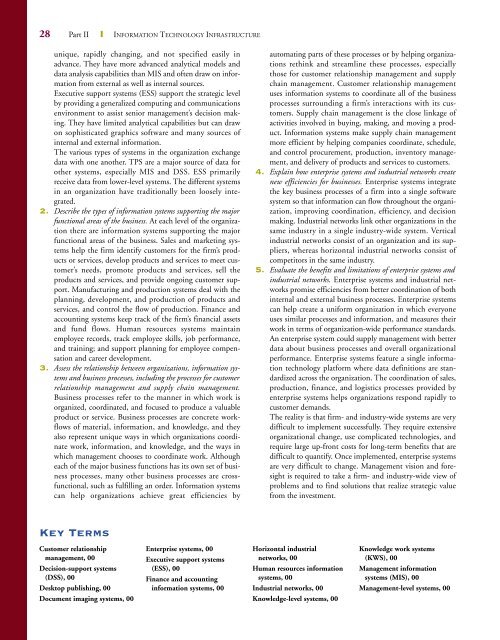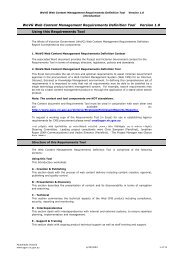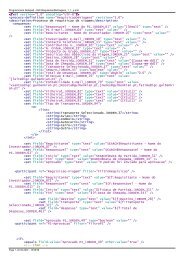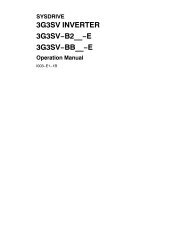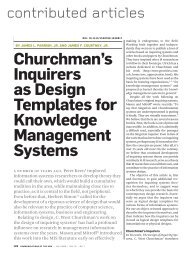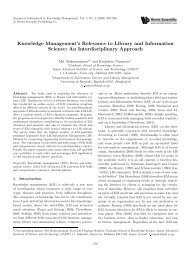2 Information Systems in the Enterprise - Main Web
2 Information Systems in the Enterprise - Main Web
2 Information Systems in the Enterprise - Main Web
Create successful ePaper yourself
Turn your PDF publications into a flip-book with our unique Google optimized e-Paper software.
28 Part II ❙ INFORMATION TECHNOLOGY INFRASTRUCTURE<br />
unique, rapidly chang<strong>in</strong>g, and not specified easily <strong>in</strong><br />
advance. They have more advanced analytical models and<br />
data analysis capabilities than MIS and often draw on <strong>in</strong>formation<br />
from external as well as <strong>in</strong>ternal sources.<br />
Executive support systems (ESS) support <strong>the</strong> strategic level<br />
by provid<strong>in</strong>g a generalized comput<strong>in</strong>g and communications<br />
environment to assist senior management’s decision mak<strong>in</strong>g.<br />
They have limited analytical capabilities but can draw<br />
on sophisticated graphics software and many sources of<br />
<strong>in</strong>ternal and external <strong>in</strong>formation.<br />
The various types of systems <strong>in</strong> <strong>the</strong> organization exchange<br />
data with one ano<strong>the</strong>r. TPS are a major source of data for<br />
o<strong>the</strong>r systems, especially MIS and DSS. ESS primarily<br />
receive data from lower-level systems. The different systems<br />
<strong>in</strong> an organization have traditionally been loosely <strong>in</strong>tegrated.<br />
2. Describe <strong>the</strong> types of <strong>in</strong>formation systems support<strong>in</strong>g <strong>the</strong> major<br />
functional areas of <strong>the</strong> bus<strong>in</strong>ess. At each level of <strong>the</strong> organization<br />
<strong>the</strong>re are <strong>in</strong>formation systems support<strong>in</strong>g <strong>the</strong> major<br />
functional areas of <strong>the</strong> bus<strong>in</strong>ess. Sales and market<strong>in</strong>g systems<br />
help <strong>the</strong> firm identify customers for <strong>the</strong> firm’s products<br />
or services, develop products and services to meet customer’s<br />
needs, promote products and services, sell <strong>the</strong><br />
products and services, and provide ongo<strong>in</strong>g customer support.<br />
Manufactur<strong>in</strong>g and production systems deal with <strong>the</strong><br />
plann<strong>in</strong>g, development, and production of products and<br />
services, and control <strong>the</strong> flow of production. F<strong>in</strong>ance and<br />
account<strong>in</strong>g systems keep track of <strong>the</strong> firm’s f<strong>in</strong>ancial assets<br />
and fund flows. Human resources systems ma<strong>in</strong>ta<strong>in</strong><br />
employee records, track employee skills, job performance,<br />
and tra<strong>in</strong><strong>in</strong>g; and support plann<strong>in</strong>g for employee compensation<br />
and career development.<br />
3. Assess <strong>the</strong> relationship between organizations, <strong>in</strong>formation systems<br />
and bus<strong>in</strong>ess processes, <strong>in</strong>clud<strong>in</strong>g <strong>the</strong> processes for customer<br />
relationship management and supply cha<strong>in</strong> management.<br />
Bus<strong>in</strong>ess processes refer to <strong>the</strong> manner <strong>in</strong> which work is<br />
organized, coord<strong>in</strong>ated, and focused to produce a valuable<br />
product or service. Bus<strong>in</strong>ess processes are concrete workflows<br />
of material, <strong>in</strong>formation, and knowledge, and <strong>the</strong>y<br />
also represent unique ways <strong>in</strong> which organizations coord<strong>in</strong>ate<br />
work, <strong>in</strong>formation, and knowledge, and <strong>the</strong> ways <strong>in</strong><br />
which management chooses to coord<strong>in</strong>ate work. Although<br />
each of <strong>the</strong> major bus<strong>in</strong>ess functions has its own set of bus<strong>in</strong>ess<br />
processes, many o<strong>the</strong>r bus<strong>in</strong>ess processes are crossfunctional,<br />
such as fulfill<strong>in</strong>g an order. <strong>Information</strong> systems<br />
can help organizations achieve great efficiencies by<br />
Key Terms<br />
Customer relationship<br />
management, 00<br />
Decision-support systems<br />
(DSS), 00<br />
Desktop publish<strong>in</strong>g, 00<br />
Document imag<strong>in</strong>g systems, 00<br />
<strong>Enterprise</strong> systems, 00<br />
Executive support systems<br />
(ESS), 00<br />
F<strong>in</strong>ance and account<strong>in</strong>g<br />
<strong>in</strong>formation systems, 00<br />
automat<strong>in</strong>g parts of <strong>the</strong>se processes or by help<strong>in</strong>g organizations<br />
reth<strong>in</strong>k and streaml<strong>in</strong>e <strong>the</strong>se processes, especially<br />
those for customer relationship management and supply<br />
cha<strong>in</strong> management. Customer relationship management<br />
uses <strong>in</strong>formation systems to coord<strong>in</strong>ate all of <strong>the</strong> bus<strong>in</strong>ess<br />
processes surround<strong>in</strong>g a firm’s <strong>in</strong>teractions with its customers.<br />
Supply cha<strong>in</strong> management is <strong>the</strong> close l<strong>in</strong>kage of<br />
activities <strong>in</strong>volved <strong>in</strong> buy<strong>in</strong>g, mak<strong>in</strong>g, and mov<strong>in</strong>g a product.<br />
<strong>Information</strong> systems make supply cha<strong>in</strong> management<br />
more efficient by help<strong>in</strong>g companies coord<strong>in</strong>ate, schedule,<br />
and control procurement, production, <strong>in</strong>ventory management,<br />
and delivery of products and services to customers.<br />
4. Expla<strong>in</strong> how enterprise systems and <strong>in</strong>dustrial networks create<br />
new efficiencies for bus<strong>in</strong>esses. <strong>Enterprise</strong> systems <strong>in</strong>tegrate<br />
<strong>the</strong> key bus<strong>in</strong>ess processes of a firm <strong>in</strong>to a s<strong>in</strong>gle software<br />
system so that <strong>in</strong>formation can flow throughout <strong>the</strong> organization,<br />
improv<strong>in</strong>g coord<strong>in</strong>ation, efficiency, and decision<br />
mak<strong>in</strong>g. Industrial networks l<strong>in</strong>k o<strong>the</strong>r organizations <strong>in</strong> <strong>the</strong><br />
same <strong>in</strong>dustry <strong>in</strong> a s<strong>in</strong>gle <strong>in</strong>dustry-wide system. Vertical<br />
<strong>in</strong>dustrial networks consist of an organization and its suppliers,<br />
whereas horizontal <strong>in</strong>dustrial networks consist of<br />
competitors <strong>in</strong> <strong>the</strong> same <strong>in</strong>dustry.<br />
5. Evaluate <strong>the</strong> benefits and limitations of enterprise systems and<br />
<strong>in</strong>dustrial networks. <strong>Enterprise</strong> systems and <strong>in</strong>dustrial networks<br />
promise efficiencies from better coord<strong>in</strong>ation of both<br />
<strong>in</strong>ternal and external bus<strong>in</strong>ess processes. <strong>Enterprise</strong> systems<br />
can help create a uniform organization <strong>in</strong> which everyone<br />
uses similar processes and <strong>in</strong>formation, and measures <strong>the</strong>ir<br />
work <strong>in</strong> terms of organization-wide performance standards.<br />
An enterprise system could supply management with better<br />
data about bus<strong>in</strong>ess processes and overall organizational<br />
performance. <strong>Enterprise</strong> systems feature a s<strong>in</strong>gle <strong>in</strong>formation<br />
technology platform where data def<strong>in</strong>itions are standardized<br />
across <strong>the</strong> organization. The coord<strong>in</strong>ation of sales,<br />
production, f<strong>in</strong>ance, and logistics processes provided by<br />
enterprise systems helps organizations respond rapidly to<br />
customer demands.<br />
The reality is that firm- and <strong>in</strong>dustry-wide systems are very<br />
difficult to implement successfully. They require extensive<br />
organizational change, use complicated technologies, and<br />
require large up-front costs for long-term benefits that are<br />
difficult to quantify. Once implemented, enterprise systems<br />
are very difficult to change. Management vision and foresight<br />
is required to take a firm- and <strong>in</strong>dustry-wide view of<br />
problems and to f<strong>in</strong>d solutions that realize strategic value<br />
from <strong>the</strong> <strong>in</strong>vestment.<br />
Horizontal <strong>in</strong>dustrial<br />
networks, 00<br />
Human resources <strong>in</strong>formation<br />
systems, 00<br />
Industrial networks, 00<br />
Knowledge-level systems, 00<br />
Knowledge work systems<br />
(KWS), 00<br />
Management <strong>in</strong>formation<br />
systems (MIS), 00<br />
Management-level systems, 00


